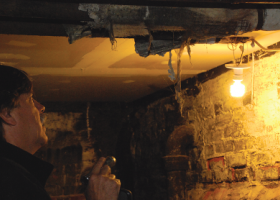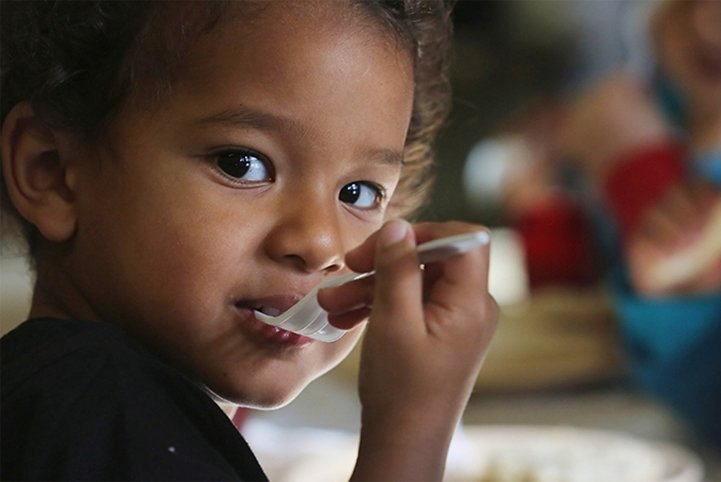Weatherization Plus Health: The Connecticut Efficient Healthy Homes Initiative
This article is part of an ongoing series from the National Association for State Community Services Programs (NASCSP), which is implementing Weatherization Plus Health on behalf of DOE. Each piece will highlight best practices and guides at the intersection of energy, housing, and health. NASCSP and DOE believe that Weatherization Plus Health can be a vehicle for showcasing the talents of the Weatherization Assistance Program’s (WAP) network and bolster the case for more funding for the WAP network as well as organizations that tackle housing-related health hazards. By simultaneously addressing energy efficiency and health and safety in low income homes, CTEHHI provides a blueprint for collaboration that puts the WAP network’s creativity and innovation on full display.
The Connecticut Efficient Healthy Homes Initiative
CTEHHI, led by The United Illuminating Company (UI) in partnership with the Connecticut Energy Efficiency Fund (the Fund) and Connecticut Light & Power (CL&P), is a great model for agencies looking to implement a Weatherization Plus Health approach. It has mobilized partners, including local governments, nonprofits, and healthcare providers, that provide weatherization, lead abatement, and other housing-related services to comprehensively address energy efficiency and health and safety issues in homes throughout Connecticut. As a result, UI and its partners are confident that they are stretching every dollar for the benefit of their low income clients, while putting the partnership in a better position when competing for federal funding for health, housing, and energy needs.
How It Started
The Connecticut Children’s Medical Center’s Lead Action for Medicaid Primary Prevention (LAMPP) project is an early intervention and prevention program that educates the public about the dangers of lead poisoning and remediates lead hazards in low income homes. Funded by the U.S. Department of Housing and Urban Development (HUD), LAMPP has made over 1,400 homes lead safe since 2003. Through previous work with community action agencies across the state, LAMPP was familiar with the WAP program and the health and safety measures it can complete. They also knew that UI and CL&P ran a low income weatherization program funded by ratepayers through the Connecticut Energy Efficiency Fund.
LAMPP was convinced it could use new partnerships with UI and CL&P to leverage funding for additional health and safety measures and, along with other partners, build a sustainable model for addressing all of the health, housing, and energy needs of its low income clients. After approaching UI and encouraging them to apply for a DOE Weatherization Innovation Pilot Program (WIPP) grant, UI competed successfully for this funding to streamline programs between partners, thereby cutting costs where services overlapped. By partnering with UI and CL&P and integrating energy and health services, LAMPP has since been able to secure additional grant funding from HUD to continue its good work.
How Does it Work?
UI and CL&P are the lead partners in CTEHHI because of their capacity to address energy efficiency and major health issues. Intake, processed through many different partners, is used as a means to refer low income clients to UI and CL&P. CTEHHI sends a team to a client’s household to perform both an energy assessment and a healthy homes checkup that includes client education on identified home health and safety issues. The team installs energy conservation measures, such as energy efficient light bulbs, simple air sealing measures, and water-saving measures. Based on the results of the energy assessment and health and safety checkup, one of two scenarios occurs:
- UI generates a work order and a weatherization crew re-enters the home to perform a more comprehensive installation of weatherization measures, such as furnace tune-ups and insulation, as well as health and safety measures, following DOE WAP Health and Safety Guidance 11-6. A third party then completes a final inspection of the work.
- If there are instances where the weatherization program cannot address certain issues, leading to a deferral, UI generates a work order in consultation with partners to cost effectively address health and safety concerns that cannot be addressed through UI and CL&P’s weatherization program. Once partners address these concerns, the agency generates a referral so that UI and CL&P crews can proceed with completing weatherization, including health and safety measures, as described above.
Partnerships
Developing mutually beneficial partnerships is at the core of CTEHHI’s success. Current partners of CTEHHI include Bridgeport Neighborhood Trust, the City of New Haven, the City of Bridgeport, Connecticut Department of Public Health, Connecticut Housing Finance Authority, L. Wagner & Associates, NauVEL, NeighborWorks New Horizons, and Yale-New Haven Hospital. Three roles for partners offer models for best practice:
- Intake and outreach, including providing referrals into CTEHHI
- Providing guidance on program structure and process, leading to partner investment in success
- Referrals to and from CTEHHI for health and safety
To create and maintain fruitful partnerships, it is essential that the larger group understands each organization’s mission. In 2010, UI started its first meeting with a “status assessment” that queried all partners on questions, such as:
- What health and safety interventions do you provide?
- How many units can you contribute?
- How much funding do you have available?
- How do you rank your priorities?
The status assessment informs CTEHHI’s use of referrals among its partners. In addition, CTEHHI makes a deliberate effort to reach out to all partners to update them, maintaining a sense of community and trust. “Chris [Corcoran, Project Manager of LAMPP] and I know each other’s phone numbers by heart,” Julia Hatton, Project Manager of CTEHHI at UI said, stressing that these types of personal connections can be transferred to the work the group performs collaboratively. Partners also take turns hosting a bi-monthly meeting to keep each other informed of their work, show off their facilities, and discuss strategies for moving the initiative forward.
These meetings also provide an opportunity to reaffirm commitment to the initiative, as partners are reminded why it is beneficial for their organization to be involved; namely, it enhances their capacity to offer additional client services, making their interventions more efficient and cost-effective. CTEHHI ensures that the referral process is easy by equipping partners with tools, including brochures and necessary forms for admission into the program, as well as flow charts describing the process their clients will go through when they reach CTEHHI. This provides partners with the assurance that UI and CL&P will take good care of their clients. Finally, the meetings offer a chance to discover additional cost-sharing opportunities.
[[{"fid":"652","view_mode":"default","fields":{"format":"default","field_file_image_alt_text[und][0][value]":"Client Services form","field_file_image_title_text[und][0][value]":"","field_folder[und]":"823"},"type":"media","link_text":null,"attributes":{"height":"200","width":"559","class":"media-element file-default"}}]]
Challenges
An early focus on program development enabled CTEHHI to confront a series of potential barriers often faced by other weatherization programs around the country. These include:
- Varying income eligibilities for different programs
- Varying interventions that are achievable depending on client location and available funding in a client’s jurisdiction
- Administrative and logistic differences between programs
To address the question of differing income eligibility guidelines, CTEHHI created a chart that provides an easy visual for partners to determine program qualifications. CTEHHI also created a verification system so that proof of income presented to partnering programs is sufficient for CTEHHI’s purposes of determining client eligibility. In addition, LAMPP and CTEHHI make joint presentations to educate partners about the various programs available for clients and their income eligibility differences.
To facilitate referrals, CTEHHI created a health and safety checkup to be performed at the initial weatherization visit that includes referral opportunities for additional health and safety interventions. On the checkup sheet, referral opportunities are highlighted in gray; see
Figure 2.
Lowering barriers that separate programs is an ongoing effort. Part of CTEHHI’s strategy has been to demonstrate to their vendors and contractors that they are already a healthy homes program. When UI and CL&P crews realized that their work includes healthy homes measures, it generated excitement. Weatherization crews already receive training that includes Lead Safe Weatherization and EPA’s Renovation, Repair and Painting Rule (regarding lead paint); enhancing this capacity in the area of healthy homes, crews have been offered cross training through the National Center for Healthy Housing’s Healthy Homes Essentials course. LAMPP and other partners have provided energy efficiency education to their healthy homes crews to show the health and safety work being completed during weatherization. Cross training on both the energy and health sides of this collaborative has strengthened partner engagement.
The Path Forward
CTEHHI’s approach has created a comprehensive strategy for energy, housing, and health. WAP agencies can learn from their example of partner engagement and thinking through potential barriers in expanding program capacity.
Often housed in Community Action Agencies, WAP agencies have a host of partners within their own agencies that they can engage for referral opportunities, intake purposes, and client education. They can also collaborate with utility companies, faith-based groups, and other nontraditional partners to pursue any opportunity to expand client services. To build the program capacity necessary to secure funding for a comprehensive initiative, WAP must engage their partners effectively, plan ways to overcome barriers, start small with achievable initiatives, and tout their successes with data. Through Weatherization Plus Health and by following the lead of model programs like CTEHHI, WAP agencies can demonstrate their capacity for innovation as part of the nation’s largest program that reduces energy bills and improves health and safety in the homes of low-income families.






